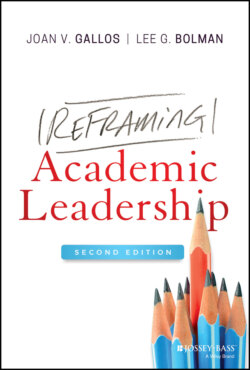Читать книгу Reframing Academic Leadership - Lee G. Bolman - Страница 30
Model I Assumptions
ОглавлениеLurking in Model I is a set of core assumptions that other people are dangerous, so we better not let our guard down. These assumptions cause individuals to follow predictable steps in their attempt to protect themselves in their interactions with others. We can see this progression in the exchanges between Sarah and George.
1 Assume that the problem is caused by the other person(s). Sarah sees herself as earnest and principled, simply trying to do a good job under difficult circumstances. She expects the meeting to be challenging because George is routinely exasperating. Her implicit assumption is “George is the problem, and I have to be the solution.”
2 Develop and implement a private, unilateral diagnosis and solution. Sarah sees at least two problems. The first is George's work performance, which she hopes to discuss with him. The second is that she expects George to be defensive and unpleasant in response to feedback on his performance. But it does not occur to Sarah to surface that concern with George or to enlist his thoughts on how they can have a productive conversation about difficult issues. Sarah's strategy instead is threefold: start positive; flatter George; and stay cool, rational, and factual. We have no direct evidence of what George was thinking in advance of the meeting, but it is likely he too was pessimistic. His consistent sarcasm and criticism convey little confidence in Sarah's leadership. Both parties expected failure, and both saw their pessimism as undiscussable.
3 Get the others to change and be who you want them to be. Model I leads people to use one or more of three basic strategies to accomplish the makeover: (1) facts, logic, and rational persuasion (argue the merits of your point of view); (2) indirect influence (ease in, ask leading questions, cajole or manipulate the other person); or (3) direct critique (tell the other person directly what he or she is doing wrong and how he or she should change). Sarah made a half‐hearted and somewhat clumsy stab at easing into the conversation with George. The results were less than stellar. She then shifted to facts and logic, arguing the merits of her case. George riposted with disparagement of Sarah's reputation and experience. It was all downhill from there.
4 If the other person resists or becomes defensive, it confirms the initial diagnosis that the other is the cause of the problem. George's reactions and resistance to discussion of his performance proved to Sarah that her pessimism was justified and her diagnosis was spot on: George was as defensive and exasperating as expected. It is likely that Sarah's raised voice and rising emotionality confirmed George's perception that she was in over her head.
5 Respond to resistance with some combination of intensifying pressure and protecting the other person or with rejection. Sarah responded to George's resistance by intensifying the pressure when she told him to open his mind and “listen to someone else for a change.” That led George to reject her before she could figure out what to do next – or to reject him first.
6 If your efforts are less successful than hoped, it is the other person's fault. Sarah sees the meeting as a failure and regrets that she couldn't do anything to make it go better. In her mind, it's still George's fault: he kept “trying to change the subject,” and he was “infuriating,” “arrogant,” and “totally uncooperative.” Sarah does not see how her behavior might have encouraged or allowed George to act in the very ways she feared he would.
